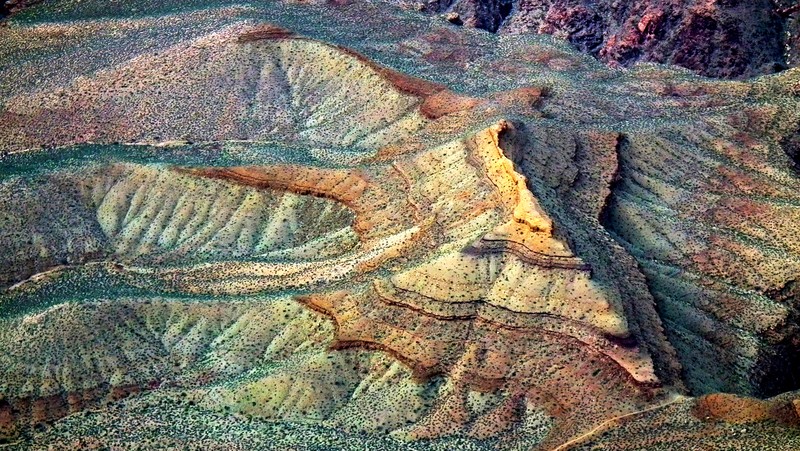John Clemens, a researcher from Stellenbosch University and one of the winners in the EGU Photo Contest 2014, opens our eyes to erosional processes in the Grand Canyon in this week’s Imaggeo on Mondays…
The photo below was taken late in the afternoon while doing some geological tourism at the Grand Canyon in Arizona, USA. The light at this time of day is ideal for such locations as it has a yellow quality and the low sun angle emphasises the contours of the land. I was on a flying visit in connection with the South-Central Regional Meeting of the Geological Society of America (held in Austin Texas). I attended this meeting because it contained a special session in honour of the work of the late Bruce Chappell and the late Alan White – two giants of late 20th century granite geology. This has nothing to do with the visit to the Grand Canyon, and even less to do with the processes that sculpted the landforms depicted.

Middle Cambrian Bright Angel Shale in the Grand Canyon, USA – one of the winning images in the EGU Photo Contest 2014. (Credit: John Clemens via imaggeo.egu.eu)
I am not a geomorphologist, but while walking along the canyon’s south rim this feature – way down towards the bottom of the inner canyon – caught my eye. Here lies the Middle Cambrian Bright Angel Shale, a variably coloured sequence of relatively soft sedimentary rocks. This lies above the more recrystallised Proterozoic rocks of the Grand Canyon Supergroup, which provide a relatively hard and stable base for the shale. Above the shale, the rocks have been stripped off by mass wasting and water erosion, leaving this vulnerable sequence exposed to the elements. There are few hard layers amongst the shale, so rain storms and snow-melt from higher altitudes combine with the desert wind to efficiently carve its shape. The shale’s remains are then washed into the inner canyon for transport down the Colorado River. In the photograph you can see a hiking trail disappearing off the edge of the inner canyon and heading steeply down to the river, through the Palaeoproterozoic regional metamorphic rocks of the Vishnu Schist.
The erosional remnant of the Bright Angel Shale has been saved (temporarily) from destruction by the presence of the slightly harder brownish layers that you can see in the image. Nevertheless, the feature is not long for this world. The harder layers that give the spider-like shape to the outcrop are nearly gone and the ridge at the top is just a narrow remnant of what was once a more extensive butte. The numerous ephemeral streams that are responsible for the canyon’s destruction are clearly visible. There terrain is decorated by only a few small green desert shrubs, which offer scant resistance to the erosion that will eventually obliterate this fantastic feature.
Since this image was captured, I have invested in some higher-quality camera equipment and have taken up high-dynamic-range (HDR) photography. Readers interested to see some of these images, including some taken during the meeting in Vienna, can have a look here.
By John Clemens, Stellenbosch University
Imaggeo is the EGU’s open access geosciences image repository. Photos uploaded to Imaggeo can be used by scientists, the press and the public provided the original author is credited. Photographers also retain full rights of use, as Imaggeo images are licensed and distributed by the EGU under a Creative Commons licence. You can submit your photos here.

Pingback: Wordpress Blogs - Wordpress Blogs .NET